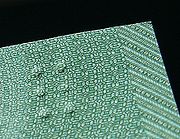
Canadian currency tactile feature
Encyclopedia

Canadian banknotes
Canadian banknotes are the banknotes of Canada, denominated in Canadian dollars . In everyday usage, they are called bills. Currently, they are issued in five, ten, twenty, fifty, and hundred dollar denominations. All current notes are issued by the Bank of Canada, which released its first series...
. The feature indicates the banknote denomination in the upper right corner of the face side of the bill using a series of raised dots. It was suggested by Bruno Thériault
Bruno Thériault
Bruno Thériault was a blind piano tuner and former regional administrator for the Canadian National Institute for the Blind...
, an administrator for the Canadian National Institute for the Blind
Canadian National Institute for the Blind
CNIB is a volunteer agency and charitable organization dedicated to assisting Canadians who are blind or living with vision loss, and to provide information about vision health for all Canadians...
, and designed by Dr. Susan Lederman, a professor of Psychology
Psychology
Psychology is the study of the mind and behavior. Its immediate goal is to understand individuals and groups by both establishing general principles and researching specific cases. For many, the ultimate goal of psychology is to benefit society...
at Queen's University
Queen's University
Queen's University, , is a public research university located in Kingston, Ontario, Canada. Founded on 16 October 1841, the university pre-dates the founding of Canada by 26 years. Queen's holds more more than of land throughout Ontario as well as Herstmonceux Castle in East Sussex, England...
.
Although similar in appearance to Braille
Braille
The Braille system is a method that is widely used by blind people to read and write, and was the first digital form of writing.Braille was devised in 1825 by Louis Braille, a blind Frenchman. Each Braille character, or cell, is made up of six dot positions, arranged in a rectangle containing two...
, it differs because standard Braille was deemed too sensitive. The currency denomination must be recognized easily, thus the banknotes use full Braille blocks (or cells) of 6 dots. The $5 bill has one cell, with the $10, $20, and $50 denominations each having one more cell than previous. The $100 bill has two cells arranged such that there is a space of two empty cells between them.
A very similar system of tactile raised dots is now being implemented in a new series of notes for the Costa Rican colón
Costa Rican colón
The colón is the currency of Costa Rica. The plural is colones in Spanish, but English speakers often say colons instead. The ISO 4217 code is CRC....
.

